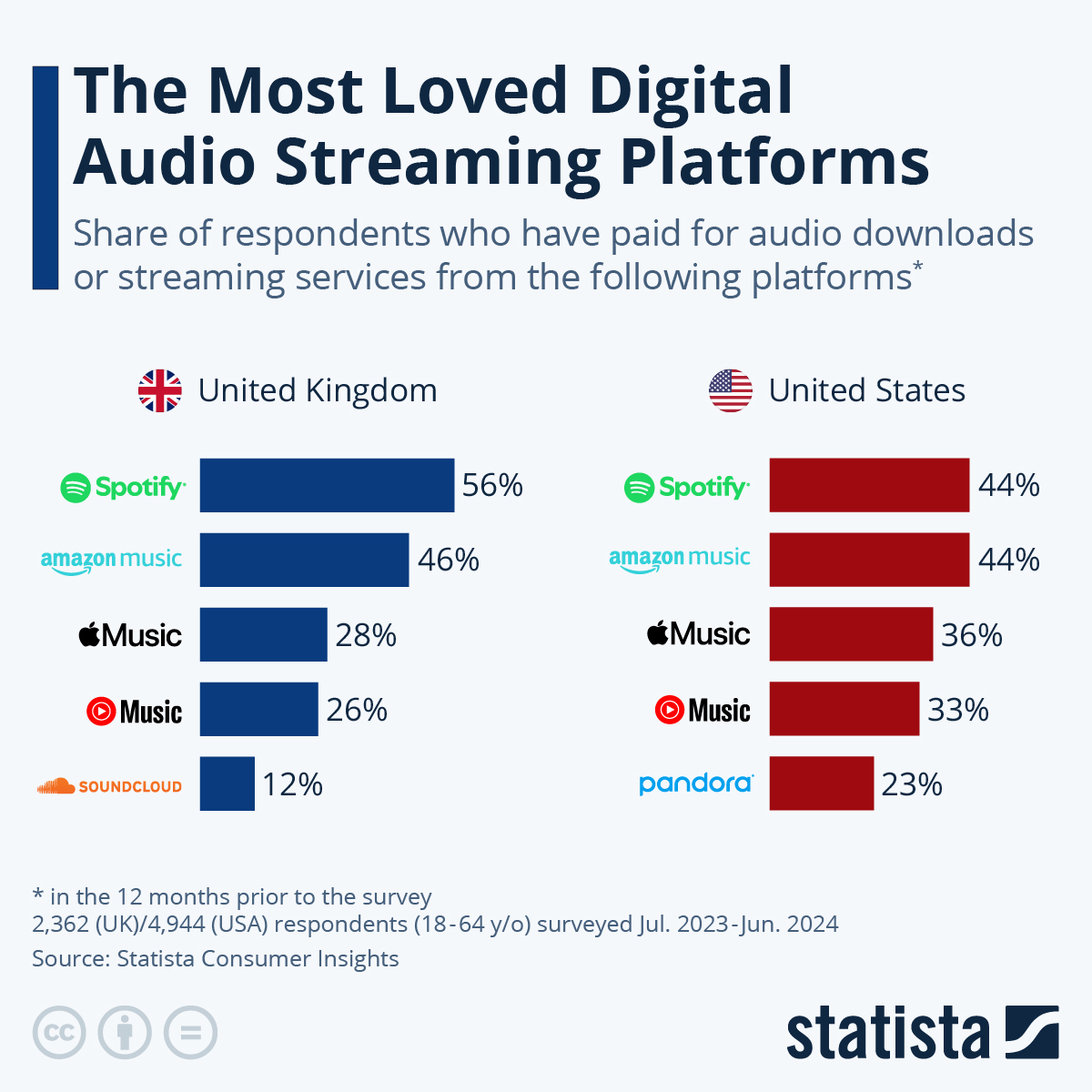Before we dive deep into the SWOT analysis, let’s get the business overview of Spotify. Spotify Technology S.A. is a Swedish audio streaming and media services provider founded in 2006 by Daniel Ek and Martin Lorentzon.
The company is headquartered in Stockholm, Sweden, and has a legal domicile in Luxembourg. Spotify has revolutionized the music industry by offering users an extensive library of millions of songs, podcasts, and other audio content through its platform.
Today, more listeners than ever can discover, manage, and enjoy over 100 million tracks, more than 5 million podcast titles, and 350,000 audiobooks a la carte on Spotify. We are the world’s most popular audio streaming subscription service with more than 602 million users, including 236 million subscribers across 184 markets.
Business Model: Spotify operates under a freemium model, offering both a free, ad-supported tier and a premium, subscription-based tier. The free tier allows users to access the platform’s library with some limitations, including ads, lower audio quality, and limited on-demand playback. The premium tier offers ad-free streaming, higher audio quality, and additional features like offline listening and unlimited skips.
Revenue Streams: Spotify primarily generates revenue from premium subscriptions and advertising.
- Premium Subscriptions: A significant portion of Spotify’s revenue comes from premium subscribers who pay a monthly fee for an ad-free experience and additional features. The company offers various subscription plans, including individual, family, student, and duo plans, with different pricing tiers depending on the market.
- Advertising: Spotify’s free tier is supported by advertising, and the company generates revenue from advertisers who want to reach its user base. Spotify offers various ad formats, such as audio, video, display ads, sponsored playlists, and branded experiences.
In 2023, music streaming service Spotify generated a revenue of over 13.2 billion euros, up from 11 billion in the previous year. The majority of Spotify’s revenues came from its premium subscribers rather than ad placements.
Strategic Partnerships and Acquisitions: Spotify has pursued various strategic partnerships and acquisitions to expand its content offering, enhance its technology, and increase its market reach. The company has acquired several businesses in the podcasting space, such as Anchor, Gimlet Media, and Parcast, to bolster its podcast library and creation tools. Additionally, Spotify has partnered with major record labels, artists, and technology companies to enhance its platform and grow its user base.
Competition: Spotify faces competition from various players in the music streaming industry, including Apple Music, Amazon Music, YouTube Music, and Deezer. These competitors offer similar services, with some providing additional features or bundling with other services to differentiate themselves. Despite this competition, Spotify has remained one of the leading audio streaming platforms worldwide.
Here’s a SWOT analysis for Spotify:
A SWOT analysis is a strategic planning tool used to evaluate the Strengths, Weaknesses, Opportunities, and Threats of a business, project, or individual. It involves identifying the internal and external factors that can affect a venture’s success or failure and analyzing them to develop a strategic plan. In this article, we do a SWOT Analysis of Spotify.
SWOT Analysis: Meaning, Importance, and Examples
Strengths
- Large User Base: With over 480 million active users as of December 2022, Spotify has a massive and diverse user base. This wide reach attracts advertisers and content creators, making the platform more appealing to both parties. Users on Spotify streamed 132 billion hours of content in 2022, an increase of 20% compared to 2021.
- Extensive Content Library: Spotify offers a vast library of millions of songs, podcasts, and other audio content from various genres, languages, and regions, catering to the diverse tastes of its users. This extensive selection helps attract and retain users on the platform.
- Personalized Recommendations: Spotify’s proprietary algorithms and data analysis capabilities allow the platform to provide highly personalized content recommendations for users based on their listening habits. This feature enhances user engagement and increases the likelihood of content discovery.
- User-Friendly Interface: Spotify’s app and web interface are known for their ease of use and intuitive design, allowing users to find and enjoy their favorite content quickly. This user-friendly experience helps attract and retain users on the platform.
- Freemium Model: Spotify’s freemium model allows it to attract a wide range of users by offering both a free, ad-supported tier and a premium, subscription-based tier. This approach enables the company to monetize its user base through advertising and subscriptions, catering to different user preferences.
- Brand Recognition: Spotify has established itself as a leading brand in the music streaming industry, enjoying high brand awareness and consumer trust. This recognition helps the company attract new users and maintain its competitive edge.
- Strategic Partnerships and Acquisitions: Spotify has forged strategic partnerships with major record labels, artists, and technology companies and acquired several podcasting companies to expand its content offering, enhance its technology, and increase its market reach. These collaborations and acquisitions have contributed to the company’s growth and differentiation in the market.
 You will find more infographics at Statista
You will find more infographics at Statista
Weaknesses
- Royalty Costs: A significant portion of Spotify’s revenue goes towards royalty payments to artists, record labels, and other rights holders. These costs can impact the company’s profitability and limit its ability to invest in other areas, such as content acquisition and technology development.
- Dependence on Third-Party Content: Spotify relies heavily on third-party content from record labels, artists, and podcast creators. This dependence can make the platform vulnerable to content removal, licensing disputes, or unfavorable contract renegotiations, which could negatively impact its content offering and user experience.
- Limited Diversification: Spotify’s core business primarily focuses on music and audio streaming, making the company vulnerable to changes and disruptions in the industry. While Spotify has tried to diversify by investing in podcasting, it still faces risks associated with reliance on a single industry.
- Competition from Tech Giants: Spotify faces intense competition from well-established tech giants such as Apple, Amazon, and Google, which have significant resources and diversified revenue streams. These competitors can offer additional features, such as bundled services, exclusive content, or lower pricing, which can challenge Spotify’s market position.
- Lack of Profitability: Spotify has struggled to achieve consistent profitability. The company’s investments in growth, content acquisition, and technology development, coupled with high royalty costs, have contributed to this challenge.
- Privacy Concerns and Data Security: As a data-driven company, Spotify relies heavily on user data to personalize recommendations and target advertisements. This reliance on data raises concerns about user privacy and the potential for data breaches or misuse, which could negatively impact the company’s reputation and user trust.
- Difficulty in Monetizing Free Users: While the freemium model has successfully attracted users to the platform, converting free users to paying subscribers can be challenging. Furthermore, the ad-supported tier’s revenue per user is significantly lower than that of premium subscribers, limiting the overall revenue potential from the free user base.
Opportunities
- Expanding into New Markets: Spotify can continue to expand its presence in emerging markets and regions where music streaming adoption is still growing. This expansion can help the company increase its user base and revenue generation.
- Investing in Exclusive Content: By acquiring or developing exclusive content, such as original podcasts, live performances, or exclusive artist releases, Spotify can differentiate itself from competitors and enhance its content library. Exclusive content can also increase engagement and encourage more users to subscribe to the premium tier.
- Strengthening Podcast Offerings: As podcast consumption grows, Spotify can invest more in its podcast ecosystem, including acquiring or partnering with podcast creators, enhancing podcast discovery tools, and offering monetization opportunities for creators. This investment can help Spotify further diversify its content and capitalize on the increasing popularity of podcasts.
- Developing New Revenue Streams: Spotify can explore additional revenue streams, such as live concert streaming, merchandise sales, or artist services, to diversify its income and reduce dependence on subscriptions and advertising.
- Leveraging Technology and Artificial Intelligence: Spotify can continue to invest in technology and artificial intelligence to enhance its content discovery algorithms, offer personalized experiences, and optimize its advertising platform. These improvements can help increase user engagement and improve advertiser satisfaction.
- Collaborating with Smart Devices and IoT: As smart devices and the Internet of Things (IoT) become more prevalent, Spotify can explore partnerships and integrations with these technologies to offer seamless streaming experiences across various devices and environments, further strengthening its user experience and market reach.
- Focusing on User-Centric Features: By continuously developing and refining user-centric features, such as social listening, improved playlists, or music discovery tools, Spotify can further enhance its platform’s value proposition and foster user loyalty.
- Engaging in Strategic Partnerships and Acquisitions: Spotify can continue to seek strategic partnerships and acquisitions that align with its growth strategy, enabling the company to expand its content offerings, enter new markets, and enhance its technology and capabilities.
Threats
- Intense Competition: The music streaming market is highly competitive, with rivals like Apple Music, Amazon Music, YouTube Music, and Deezer offering similar services. These competitors, particularly those backed by tech giants, have significant resources and can invest in exclusive content, innovative features, or aggressive pricing strategies, potentially threatening Spotify’s market share.
- Increasing Royalty Costs: As the music streaming industry grows, artists and record labels may demand higher royalty rates or renegotiate existing contracts. These increased costs could impact Spotify’s profitability and its ability to invest in other areas of its business.
- Regulatory Changes and Copyright Issues: Changes in copyright laws, licensing agreements, or regulatory frameworks in different countries could impact Spotify’s content offering, cost structure, or market access. Such changes may require the company to adapt its business model or negotiate new contracts with rights holders, potentially affecting its operations and profitability.
- Dependence on Third-Party Content: Spotify’s reliance on third-party content exposes the platform to risks associated with content removal, licensing disputes, or unfavorable contract renegotiations. Losing access to popular content or facing unfavorable terms could negatively impact the platform’s user experience and market position.
- Privacy and Data Security Concerns: As a data-driven company, Spotify must address user privacy and data security concerns. Any incidents involving data breaches, misuse of user data, or non-compliance with data protection regulations could damage the company’s reputation, erode user trust, and lead to legal penalties or increased regulatory scrutiny.
- Challenges in Monetizing Free Users: Spotify’s ad-supported tier generates significantly lower revenue per user than its premium tier. As the company grows its user base, it may face challenges in effectively monetizing its free users and converting them into paying subscribers.
- Rapid Technological Changes: The audio streaming industry is subject to rapid technological changes and shifting consumer preferences. Failure to adapt to new technologies, platforms, or consumer demands could result in a loss of market share or user engagement.
- Economic Uncertainty: Economic downturns or global economic uncertainty could impact consumer spending, leading to lower subscription rates, reduced advertising budgets, or increased price sensitivity among users. These factors could negatively impact Spotify’s revenue and growth prospects.











